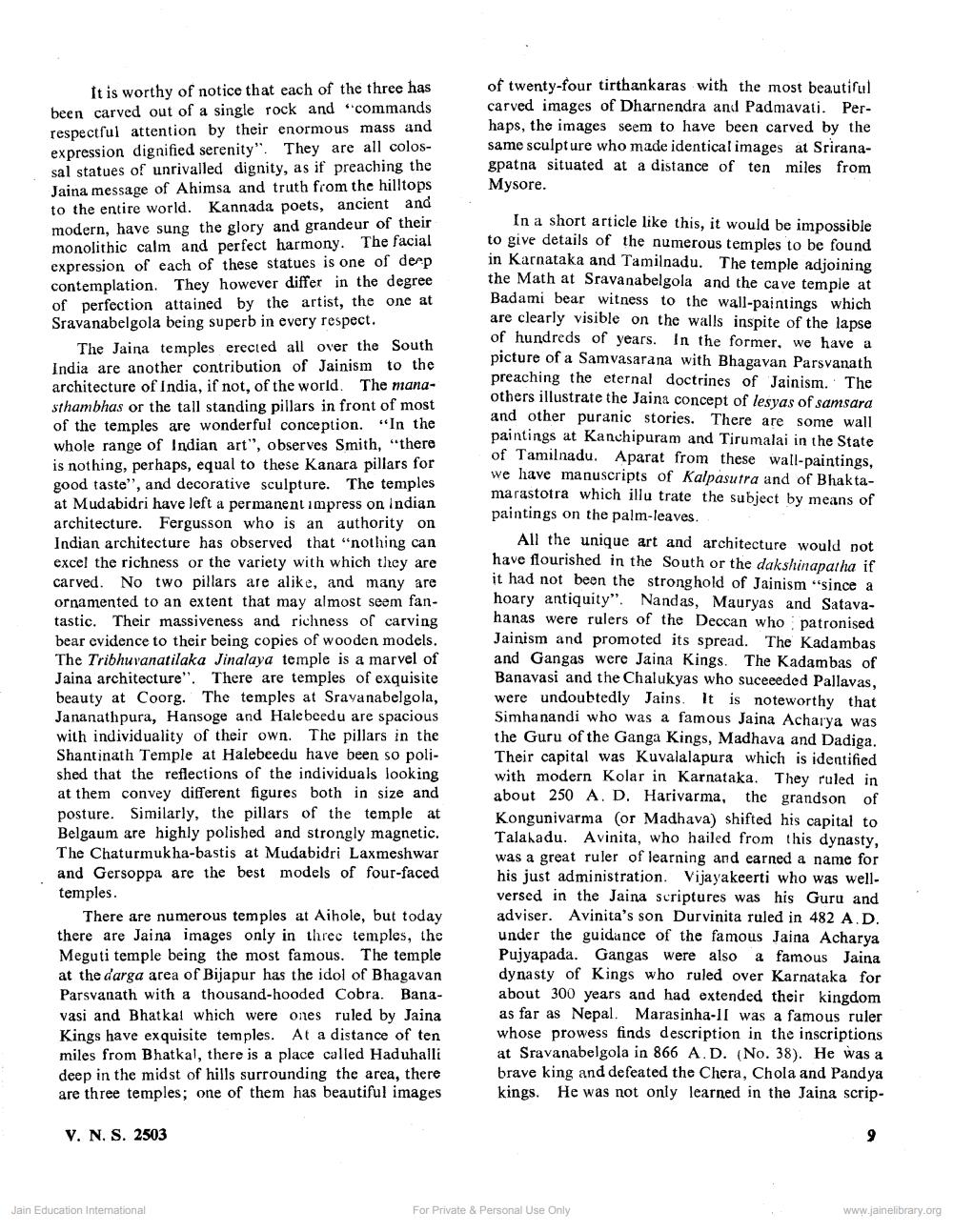Book Title: Jainism in South India Author(s): T K Tukol Publisher: Z_Rajendrasuri_Janma_Sardh_Shatabdi_Granth_012039.pdf View full book textPage 4
________________ It is worthy of notice that each of the three has been carved out of a single rock and "commands respectful attention by their enormous mass and expression dignified serenity". They are all colossal statues of unrivalled dignity, as if preaching the Jaina message of Ahimsa and truth from the hilltops to the entire world. Kannada poets, ancient and modern, have sung the glory and grandeur of their monolithic calm and perfect harmony. The facial expression of each of these statues is one of deep contemplation. They however differ in the degree of perfection attained by the artist, the one at Sravanabelgola being superb in every respect. The Jaina temples erected all over the South India are another contribution of Jainism to the architecture of India, if not, of the world. The manasthambhas or the tall standing pillars in front of most of the temples are wonderful conception. "In the whole range of Indian art", observes Smith, "there is nothing, perhaps, equal to these Kanara pillars for good taste", and decorative sculpture. The temples at Mudabidri have left a permanent impress on Indian architecture. Fergusson who is an authority on Indian architecture has observed that "nothing can excel the richness or the variety with which they are carved. No two pillars are alike, and many are ornamented to an extent that may almost seem fantastic. Their massiveness and richness of carving bear evidence to their being copies of wooden models. The Tribhuvanatilaka Jinalaya temple is a marvel of Jaina architecture". There are temples of exquisite beauty at Coorg. The temples at Sravanabelgola, Jananathpura, Hansoge and Halebeedu are spacious with individuality of their own. The pillars in the Shantinath Temple at Halebeedu have been so polished that the reflections of the individuals looking at them convey different figures both in size and posture. Similarly, the pillars of the temple at Belgaum are highly polished and strongly magnetic. The Chaturmukha-bastis at Mudabidri Laxmeshwar and Gersoppa are the best models of four-faced temples. There are numerous temples at Aihole, but today there are Jaina images only in three temples, the Meguti temple being the most famous. The temple at the darga area of Bijapur has the idol of Bhagavan Parsvanath with a thousand-hooded Cobra. Banavasi and Bhatkal which were ones ruled by Jaina Kings have exquisite temples. At a distance of ten miles from Bhatkal, there is a place called Haduhalli deep in the midst of hills surrounding the area, there are three temples; one of them has beautiful images V. N. S. 2503 Jain Education International of twenty-four tirthankaras with the most beautiful carved images of Dharnendra and Padmavati. Perhaps, the images seem to have been carved by the same sculpture who made identical images at Sriranagpatna situated at a distance of ten miles from Mysore. In a short article like this, it would be impossible to give details of the numerous temples to be found in Karnataka and Tamilnadu. The temple adjoining the Math at Sravanabelgola and the cave temple at Badami bear witness to the wall-paintings which are clearly visible on the walls inspite of the lapse of hundreds of years. In the former, we have a picture of a Samvasarana with Bhagavan Parsvanath preaching the eternal doctrines of Jainism. The others illustrate the Jaina concept of lesyas of samsara and other puranic stories. There are some wall paintings at Kanchipuram and Tirumalai in the State of Tamilnadu. Aparat from these wall-paintings, we have manuscripts of Kalpasutra and of Bhaktamarastotra which illu trate the subject by means of paintings on the palm-leaves. All the unique art and architecture would not have flourished in the South or the dakshinapatha if it had not been the stronghold of Jainism "since a hoary antiquity". Nandas, Mauryas and Satavahanas were rulers of the Deccan who patronised Jainism and promoted its spread. The Kadambas and Gangas were Jaina Kings. The Kadambas of Banavasi and the Chalukyas who suceeeded Pallavas, were undoubtedly Jains. It is noteworthy that Simhanandi who was a famous Jaina Acharya was the Guru of the Ganga Kings, Madhava and Dadiga. Their capital was Kuvalalapura which is identified with modern Kolar in Karnataka. They ruled in about 250 A. D. Harivarma, the grandson of Kongunivarma (or Madhava) shifted his capital to Talakadu. Avinita, who hailed from this dynasty, was a great ruler of learning and earned a name for his just administration. Vijayakeerti who was wellversed in the Jaina scriptures was his Guru and adviser. Avinita's son Durvinita ruled in 482 A.D. under the guidance of the famous Jaina Acharya Pujyapada. Gangas were also a famous Jaina dynasty of Kings who ruled over Karnataka for about 300 years and had extended their kingdom as far as Nepal. Marasinha-II was a famous ruler whose prowess finds description in the inscriptions at Sravanabelgola in 866 A. D. (No. 38). He was a brave king and defeated the Chera, Chola and Pandya kings. He was not only learned in the Jaina scrip For Private & Personal Use Only 9 www.jainelibrary.orgPage Navigation
1 2 3 4 5 6
